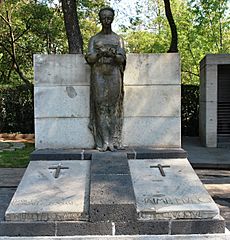Jaime Nunó facts for kids
Jaime Nunó Roca (born September 8, 1824 – died July 18, 1908) was a Spanish composer from a region called Catalonia. He is famous for writing the music for the Mexican national anthem.
Early Life and Learning
Jaime Nunó was born on September 8, 1824. His hometown was Sant Joan de les Abadesses, which is in the Girona area of Catalonia, Spain. Sadly, both his parents, Francisco Nunó and Magdalena Roca, passed away before he turned nine years old.
After his parents died, Jaime was raised by his uncle Bernard. His uncle sold silks in Barcelona and paid for Jaime's music lessons there. Jaime showed great talent. He was a skilled singer in the city's main church. He also directed choirs and played the organ. Because of his talent, he won a special scholarship to study music with the famous composer Saverio Mercadante in Naples, Italy.
Music Career
When Jaime Nunó returned to Barcelona, he became the leader of the Queen's Regimental Band in 1851. He traveled with the band to Cuba, where he met and became friends with Antonio López de Santa Anna. Santa Anna was a former Mexican president.
In 1853, Santa Anna went back to Mexico to become president again. He invited Jaime Nunó to lead the Mexican military bands. Nunó arrived just as Mexico was looking for someone to compose their national anthem. Jaime Nunó took part in the competition. He wrote the music for the words written by the Mexican poet Francisco González Bocanegra.
On August 12, 1854, Jaime Nunó was announced as the winner! The new Mexican national anthem was first performed on September 15, 1854. This special event took place at the Santa Anna Theater. A singer named Claudina Florentini and a tenor named Lorenzo Salvi performed it. Master Vitessiri conducted the orchestra.
After President Santa Anna was no longer in power, Nunó moved to the United States. He worked there as a conductor and directed operas. He even conducted concerts for Sigismond Thalberg in New York City. One of the operas he directed went on a tour across North and South America in 1864.
Later Years and Passing
After spending some time in Spain, Jaime Nunó returned to the U.S. He settled in Buffalo, New York. A Mexican journalist found him there in 1901. When the news reached Mexico, the president at the time, Porfirio Díaz, invited him to come back. Nunó did return and received many honors between 1901 and 1904.
He passed away in New York on July 18, 1908. In 1942, the Mexican government decided to move his remains. They were placed in the Rotonda de los Hombres Ilustres (which means "Rotunda of Illustrious Men") in Mexico City. His remains are still there today.
Lasting Legacy
In 2010, which was 200 years after Mexico's independence, two music experts from Catalonia, Cristian Canton and Raquel Tovar, found Jaime Nunó's only living relative. This was his great-grandson, who lived in Pelham, New York, in the U.S.
The family allowed them to look at Jaime Nunó's personal collection of documents. This collection had about 5,000 papers that had never been seen before. These included personal letters, music scores, and official documents. All this information helped Canton and Tovar write the first complete book about Nunó's life. This book was very popular and was called "an essential title to understand the musical history of Mexico."
Also, because people became interested in Jaime Nunó again, his hometown, Sant Joan de les Abadesses, opened a museum dedicated to him. It is in the house where he was born, known as El Palmàs. Since these documents were found, Jaime Nunó's music that was never played before has been performed again. A full collection of his works was published in 2012, and a recording of them was planned for 2014.
See also
 In Spanish: Jaime Nunó para niños
In Spanish: Jaime Nunó para niños



